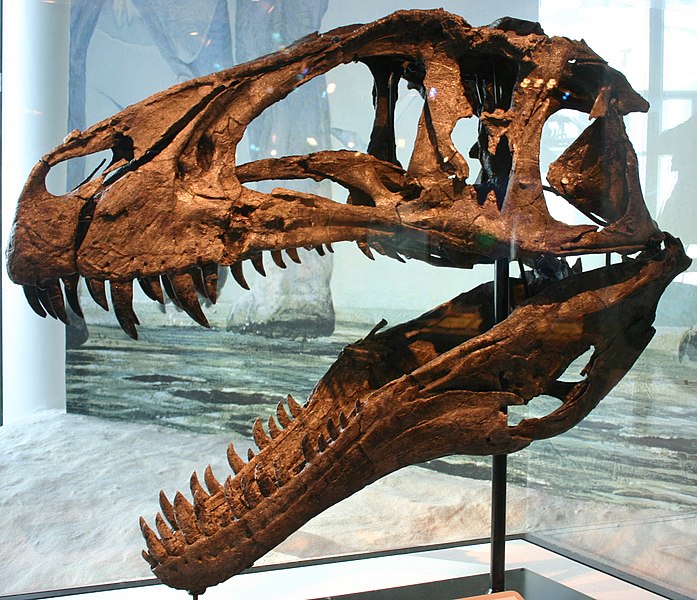 |
| The 40-foot Acrocanthosaurus is just one of the dinosaurs Dr. Steve Stevenson could clone back to life. What other creatures has Dr. Samuel Adamson brought back that might be cloned. Read below! |
“We are living in golden age of dinosaur discoveries. From all over the world, a new host of dinosaurs has been revealed . . .”
John Hurt, 2011
The above statement is so ever true, as Dr. Samuel Adamson's most recent fossil discoveries for 2013 have proven. Dr. Samuel is the head paleontologist at Animal Adventures Inc. (AAI.) and along with his wife, Indiana Adamson and the rest of their team, go out to a couple of their dig sites. The best specimens from their fossil hunting season come back to Animal Adventures Institute (AAI – this is an “offshoot” or “spin-off” if you will, company of AAI.) where Dr. Steve and the institute's other scientists see what they can create out of the DNA they are able to extract. “Most years are pretty successful digging seasons,” says Dr. Samuel, “and this year is no different. God's been good to us this year. In 2013, my team and I have been exploring two of our dig sites.” Dr. Samuel's dig sites of interest this year are in the Cedar Mountain Formation in Utah and the Horseshoe Canyon Formation in Alberta. Dr. Samuel is quoted for saying, “I really enjoyed this year's fossil hunt. Not only did we bring back multiple fossil specimens that might yield viable DNA useful for cloning, we also discovered a new species of dinosaur called Albertodromeus syntarsus. It's a small herbivorous dinosaur similar in shape to other small herbivores found in the area such as Parksosaurus and Thescelosaurus.” The paleontologist doesn't think the Albertadromeus specimens will yield DNA, but this creature's bones are useful in determing the variety of life in what was once an flourishing pre-Flood habitat before the Flood of Noah's time destroyed every air-breathing, terrestrial creature except those on Noah's Ark. He also says that the Horseshoe Canyon Formation was a lush floodplain-like habitat based on the fossil animals and plants found in the area. “This year, along with Albertodromeus, my husband, the team and I have also discovered several specimens of the dinosaurs known as Pachyrhinosaurus, a large ceratopsian dinosaur related to Triceratops, and the hadrosaur, or duck-billed dinosaur Edmontosaurus,” explains Indiana. “Back before Noah's Flood, these species were two of the many species of dinosaurs that used to populate the area. Some like Albertodromeus and Struthiomimus were relatively small herbivores that feasted on low-growing plants. The herbivores were in turn hunted by packs of Troodon and Dromaeosaurus and T. rex-relative Albertosaurus.” Indiana went on to say that the dig site in the Cedar Mountain Formation was vastly different! Here, they discovered the immense partial skeleton of a a large dinosaur called Acrocanthosaurus, a large carnosaur with a ridge along its back and tail and used its strength to take down the ornithopods and long-necked sauropods it lived with. “We've also discovered fossilized amber with containing blood-sucking insects that would have bitten the dinosaurs when alive,” she says. “They're also helpful in obtaining DNA from these long lost beasts.” As I have explained before, after the fossils are taken out of the ground, they are shipped back to AAI to be studied in greater extent by geneticist Dr. Steve Stevenson and the rest of his team. “I'm so excited about the amazing fossil discoveries Dr. Samuel has brought back for us to look at,” says Dr. Steve. “We've only just begun cleaning the plaster off that Dr. Samuel's team coated the bones in to protect them on their journey here, but by the looks of it, the fossils are in good condition and are probably viable for 4,350 year old DNA! It's a good thing dinosaur bones aren't as old as evolutionists claim they are (anywhere from around 230-65 million years old), or we wouldn't have any DNA to retrieve.” But this is only after the fossils are brought back. “The quest to clone these extinct animals back from the brink is far from done,” Samuel says, “but as far as our duty of finding and retrieving the fossils goes, it's finished. I can't wait to see what Dr. Steve recreates this time!”
Written by: Mr. Smiley
Photographer: Daniel P.
Smithwater
*Announcement*
Some
of our readers have noticed that these weekly articles are not in
order from newest to oldest. We're trying to solve this problem as
best we can. Sorry for the inconvenience
*Advertisement*
We here at Smiley’s
News, I have been working night and day to get articles ready. I
could really use some
help! So we are looking for people interested in writing (especially
kids
and teens).
If you are interested, PLEASE(!) send an email to
animaladventures@aol.com
and save me from working night and day! I’m exhausted!
Weekly
Cartoons
Next Issue: Lizzy the Music-Loving Lizard is Back



No comments:
Post a Comment